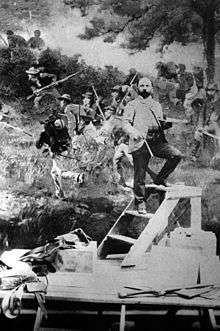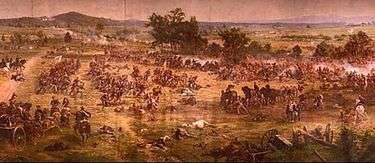Paul Philippoteaux

Paul Dominique Philippoteaux (27 January 1846 – 28 June 1923)[1] was a French artist. He is best known for a cyclorama of the Battle of Gettysburg.
Life and career
Paul Philippoteaux was born in Paris, the son of the French artist Henri Emmanuel Felix Philippoteaux. His education was at the Collège Henri-IV, the École des Beaux-Arts in Paris, and in the studio of his father, as well as the studios of Leon Cogniet, and Alexander Cabanal.
He became interested in cycloramas and in collaboration with his father created The Defence of the Fort d'Issy in 1871. Other works included Taking of Plevna (Turko-Russian War), the Passage of the Balkans, The Belgian Revolution of 1830, Attack in the Park, The Battle of Kars, The Battle of Tel-el-Kebir, and the Derniere Sortie.[2]

He was commissioned by a group of Chicago investors in 1879 to create the Gettysburg cyclorama. He spent several weeks in April 1882 at the site of the Gettysburg Battlefield to sketch and photograph the scene, and he extensively researched the battle and its events over several months. Local photographer William H. Tipton created a series of panoramic photographs shot from a wooden tower erected along present-day Hancock Avenue. The photos, pasted together, formed the basis of the composition. Philippoteaux also interviewed several survivors of the battle, including Union generals Winfield S. Hancock, Abner Doubleday, Oliver O. Howard, and Alexander S. Webb, and based his work partly on their recollections.[2]
Philippoteaux enlisted a team of five assistants, including his father until his death, to create the final work.[2] It took over a year and a half to complete.[3] The finished painting was nearly 100 yards long and weighed six tons.[4] When completed for display, the full work included not just the painting, but numerous artifacts and sculptures, including stone walls, trees, and fences.[3] The effect of the painting has been likened to the nineteenth century equivalent of an IMAX theater.[4]
Other paintings included Retour d'un pardon (1864), Vannenses (1865), Marche en Bretagne(1865), and Scene d'invasion (1866), which were all exhibited at the Paris salon.
See also
| Wikimedia Commons has media related to Paul Philippoteaux. |
Notes and references
- ↑ Murray, Jennifer M. (2013). American Civil War: The Definitive Encyclopedia and Document Collection [6 volumes]: The Definitive Encyclopedia and Document Collection. Spencer C. Tucker. p. 1521.
- 1 2 3 Thomas, Dean S. (1989). The Gettysburg Cyclorama: A Portrayal of the High Tide of the Confederacy. Gettysburg, Pennsylvania: Thomas Publications. pp. 17–19. ISBN 0-939631-14-8.
- 1 2 Heiser, John (2005). "The Gettysburg Cyclorama". Gettysburg National Military Park. National Park Service. Retrieved 2007-05-03.
- 1 2 Jarvis, Craig (May 2, 2007). "Triangle trio buys massive painting". The News & Observer (Raleigh, NC). The News and Observer Publishing Company. Archived from the original on 2007-09-27. Retrieved 2007-05-03.
External links
- American Heritage Magazine - Restoration of the Gettysburg Cyclorama
- Gettysburg cyclorama
- Gettysburg Cyclorama Exhibition Pamphlets Part of the Civil War Era Digital Collection at Gettysburg College
- Boston Public Library. Cyclorama
- Works by Paul Philippoteaux at Project Gutenberg
- Works by or about Paul Philippoteaux at Internet Archive